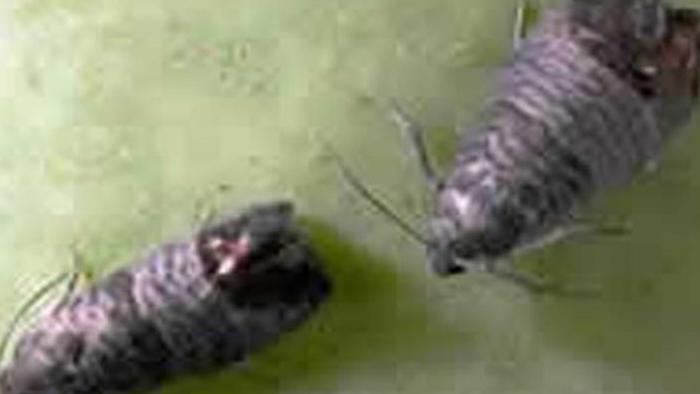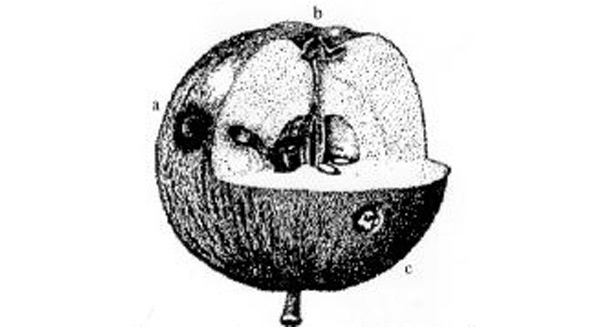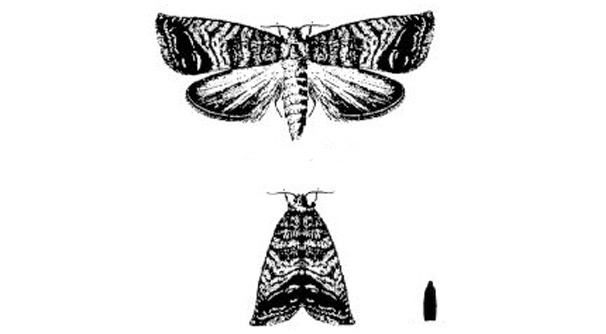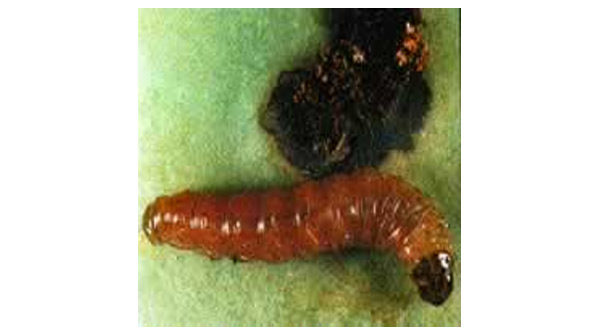Horticultural Pest and Disease Board
Codling Moth On Fruit Trees

The codling moth [Cydia pomonella (formerly Laspeyresia pomonella and Carpocapsa pomonella); Order Lepidoptera, Family Tortricidae] is one of the most serious pests of apples, but the larvae may also attack pears, crabapples, English and black walnuts, quince, and other fruits. The larva is the familiar "apple worm." It is not a native insect of the United States; it was introduced from Europe by early settlers more than 200 years ago. It became a serious pest in Ohio shortly after the Civil War. Since then, it has continued to be a problem on apples if insecticides are not used.
Damage
The larva usually tunnels to the core of the apple, greatly lowering the market value and storage quality of the fruit, as well as making it unfit for people to eat. As it feeds, it pushes out a mass of chewed material, or excrement, called "frass," which accumulates around the entrance hole. Sometimes an apple exhibits injury from more than one entrance hole, each of which is surrounded by a tiny amount of frass.

Codling moth damage
Another type of codling moth injury is known as "stings." A sting is a place where the larva chews only a short distance into the apple. The larva either dies or leaves the sting and enters at another place.
Appearance and Life Cycle
The codling moth overwinters as a fully grown larva in a silken cocoon, usually located under loose bark on the tree trunk and limbs. Cocoons may also be found in other places in the orchard such as in brush, on posts, in cracks in the soil, and on harvesting crates. The packing building, which holds apples while the fruit is being graded and packed, is a common overwintering site for larvae.
The larva transforms into a pupa and later into a grayish-brown moth. The moth is distinctive because its wings are crisscrossed with lighter gray lines, and there is a bronze or copper-colored patch near the outer margins of the forewings. The moth is 5/16 inch (8 mm) long when it is at rest with its wings folded, and has a 11/16 inch (17 mm) wingspan. The first moths of the season usually appear as the last petals fall from the apple blossoms. The peak of moth emergence occurs 4 to 12 days later, depending on weather conditions. The last moths of the overwintering brood may not appear until six or seven weeks after petal fall.

(Top) - Adult wings spread (Bottom Left) - Adult wings closed (Bottom Right) - Actual size

Codling Moth Larva
About three days after emergence, the female moths begin to lay single eggs on the fruit and leaves. Each female lays an average of 50 to 60 eggs. When temperatures are below 60 degrees F, few eggs are laid and there is little mothflight activity. The egg is tiny (1/32 inch diameter [1.2 mm]), whitish, flattened disc-shaped, and almost transparent. Eggs hatch in 8 to 14 days.
The newly hatched larva is yellowish-white with a black head; it immediately begins crawling to seek a fruit on which to feed. On the fruit, the larva wanders about seeking a rough area, such as the calyx end or scab spot, in which to make an easier entrance into the fruit. Early in the season the favorite point of entrance is apparently through the calyx, but later many larvae attack the side of the apple. The larva spends about three weeks feeding and growing. The fully grown larva is 1/2 inch (12 mm) long, white with a pinkish tinge on the upper surface, and has a brown head.
When nearly full-grown, the larva leaves the fruit by either enlarging the entrance burrow or cutting a new channel to the outside. On leaving the fruit, it seeks a suitable place to spin a cocoon similar to the type described for the overwintering larva. Although a number of these larvae may remain in cocoons until the following spring, especially in northern Ohio, many emerge as adults in 12 to 21 days. This summer brood of adults usually starts emerging sometime in July. The peak of summer moth emergence occurs about the first of August in northern Ohio, with the last emergence about September 1. In southern Ohio, these dates may be seven to ten days earlier, and in extreme northern Ohio, two to eight days later.
There may be a partial second summer brood of moths in September, especially in southern Ohio. The time period occupied by each stage of the codling moth during the summer is usually shorter in southern Ohio than in northern Ohio because higher temperatures accelerate development.
Monitoring
A pheromone (sex-attractant) trap can be used to determine exactly when the codling moth is flying. The wing-type sticky trap with the codling moth pheromone lure should be hung in the tree at bloom. See North Central Regional Extension Publication 359, Insect Traps Home Fruit Insect Control for further information on where to obtain traps.
Control
Natural control Birds are important predators of hibernating larvae that are under loose bark. Parasites can attack eggs and larvae of the developing codling moth. Some worms always escape natural control; chemical controls are thus usually needed because of consumer demand for blemish-free fruit.
Pick up and place fallen fruits in a plastic bag and put the bag in the trash weekly; larvae in these fruit will then not reach adulthood in your orchard.
Physical control
Attach corrugated cardboard strips (two to four inches wide) tightly to the tree trunk and scaffold branches in June and August to provide a site for the larvae to make their cocoons. Remove and destroy the strips after cocoons are formed. Before the bands are attached, the bark should be scraped to remove loose pieces that would prevent a tight fit by the strips.
Chemical control
Repeated applications of insecticide every 10 to 14 days are usually needed from petal-fall to near harvest. Sprays are most effective when applied just before newly hatched larvae attempt to enter the apples. If you are using a pheromone trap to monitor codling moth, the best time to spray is two weeks after the first moth catch or one week after a peak catch. Use an all-purpose fruit tree mixture or the insecticide phosmet (Imidan). Carbaryl (Sevin) will also control codling moth, but it should not be used within 30 days of full bloom because fruit thinning will result.
The author gratefully acknowledges Richard L. Miller and Alan W. Smith for authoring the 1988 version on which this fact sheet is based.
NOTE: Disclaimer - This publication contains pesticide recommendations that are subject to change at any time. These recommendations are provided only as a guide. It is always the pesticide applicator's responsibility, by law, to read and follow all current label directions for the specific pesticide being used. Due to constantly changing labels and product registration, some of the recommendations given in this writing may no longer be legal by the time you read them. If any information in these recommendations disagrees with the label, the recommendation must be disregarded. No endorsement is intended for products mentioned, nor is criticism meant for products not mentioned. The author assumes no liability resulting from the use of these recommendations.
Posted: 12/31/2014 12:05 PM
Last Updated: 01/07/2015 12:12 PM